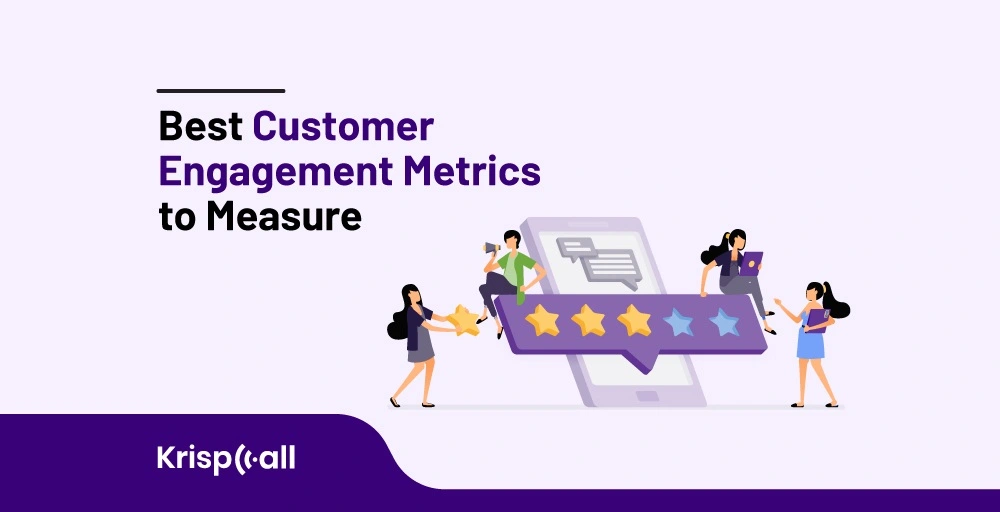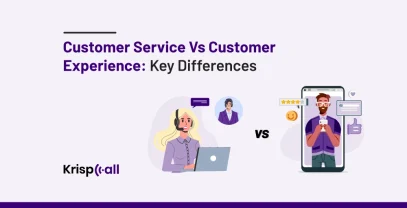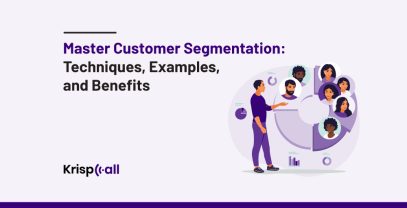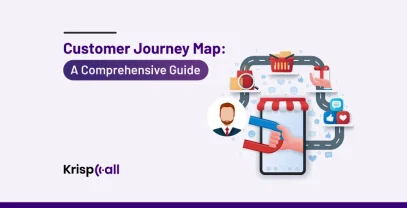Are you having trouble 😓 figuring out how interested your customers are in your business? If you want to improve it by providing a better buyer experience, then you are at the right place😄.
In today’s world🌏, measuring customer engagement is crucial for improving consumer experience and ensuring the success of your business. Measuring ⚖ user engagement helps you know how connected customers are with your business.
In this blog, we’ll learn about customer engagement metrics, their benefits, how to measure them, and the ten best metrics for user engagement.
Let’s get started!!!👇
🔑KEY HIGHLIGHTS
- Customer engagement metrics measure how well a company is connecting with its clients. Basically, they show how emotionally connected they feel to the company.
- Some benefits of user engagement metrics are improving customer loyalty, enhancing their satisfaction, and saving buyers acquisition costs.
- Measure customer engagement metrics through surveys, feedback forms, social media analytics, and website analytics.
- Net Promoter Score, Customer Satisfaction Score, Customer Lifetime Value, Customer Churn Rate, Conversion Rate, and Bounce Rate are some of the best client engagement metrics.
What Are Customer Engagement Metrics?
Customer engagement metrics are the measurement of how well a company is connecting with its clients. They look at buyers interactions, brand loyalty, and the overall experience and show how emotionally connected the customers feel to the company.

To succeed, it is important to ensure your clients are involved and interested. The stronger your relations with your customers, the more loyal they will be. To do this, you need to earn their trust, ensure their satisfaction, and gain their confidence so that they will come back again and again.
Customer Engagement Metrics Example:
A retail store called FashionFrenzy uses the Customer Satisfaction Score (CSAT) metric, which asks purchasers to rate their shopping experience on a scale of 1-10. This engages buyers and improves their experience. This data also helps FashionFrenzy improve its shopping experience.
What Are The Benefits Of Measuring Customer Engagement Metrics?
Measuring user engagement metrics improves customer satisfaction, loyalty, retention, experience, and many more. It provides valuable insights for the businesses to grow and improve their strategies.
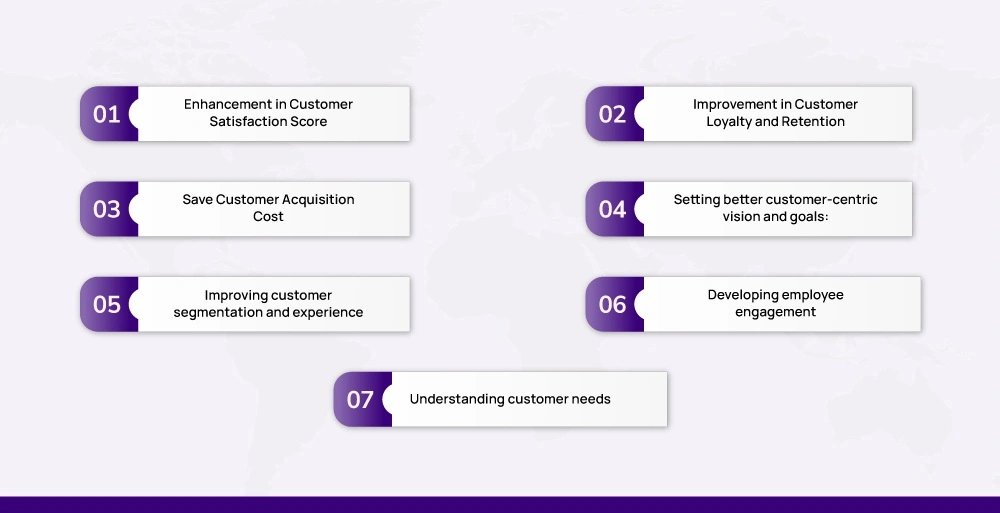
- Enhancement in Customer Satisfaction Score: Businesses can use metrics to determine user satisfaction and happiness. Some such metrics include customer feedback surveys and Net Promoter Score (NPS) surveys. These metrics allow businesses to understand what they are doing well and which areas they must work on to improve client satisfaction.
- Improvement in Customer Loyalty and Retention: Companies can observe purchase frequency and retention rates to determine what motivates their buyers to keep doing business with them. Once they know what’s working well, they can adjust their products or services to match better what the customers are looking for.
- Save Customer Acquisition Cost: Metrics like social media engagement and referral rates help companies determine how many consumers are engaged with the company and how many new clients are recommended by existing customers. By knowing this, companies can focus on spending money on consumers who don’t know about their company, which helps to save customer acquisition costs.
- Setting better customer-centric vision and goals: User engagement tracking allows companies to measure clients’ value and satisfaction from using their products or services and interacting with the brand. Analyzing these metrics allows the company to develop new products and run marketing campaigns that meet consumers’ needs and preferences.
- Improving customer segmentation and experience: Companies can use many metrics to indicate which features users value the most. This helps companies group their buyers according to their preferences and interests. As a result, companies can develop marketing strategies aimed at meeting the needs of a specific customer group.
- Developing employee engagement: Companies can ensure employee engagement and motivation by using metrics like surveys and employee feedback. This is crucial for the company’s overall success, as an engaged and motivated employee will increase productivity and improve the business’s overall performance.
- Understanding customer needs: Various metrics help companies better understand what motivates and interests clients. Thus, companies can develop content, products, and services designed to match consumers’ needs, such as personalized customer experiences.
How To Measure Customer Engagement Metrics?
As businesses attempt to develop strong relationships with their consumers, measuring user engagement has become an essential factor in their success. In this section, we will discuss different ways on how to measure customer engagement.

1. Surveys And Feedback Forms
You can measure user engagement with direct feedback through online surveys, email questionnaires, or getting someone’s direct opinion. Additionally, follow these steps:
- Design a simple, straightforward survey to collect customer feedback.
- Make the survey easily accessible and quick for buyers to complete.
- Offer an incentive to motivate clients to participate in the survey.
- Analyze the survey responses to identify common themes and areas for change.
- Implement changes based on customer feedback.
2. Social Media Analytics
Most social media platforms offer built-in analytics that tracks engagement metrics like engagement rate, reach, and click-through rate. However, to understand in detail, follow these steps:
- Determine the key social media metrics that matter most to your business, like engagement, reach, and click-through rates.
- Use analytics tools to track and analyze your social media performance.
- Use historical data and industry standards to evaluate the effectiveness of your social media strategies.
- Consistently monitor social media metrics to spot trends and identify opportunities for improvement.
- Apply insights from your analytics to continuously refine and enhance your customer engagement on social media.
3. Website Analytics
Websites have tools like Google Analytics that give much information about how people use the site. These tools help to identify bounce rate, session duration, pageviews, etc. However, follow these steps to understand how website analytics measure and improve customer engagement:
- Clearly define your website analytics goals, such as tracking user behavior, engagement, and conversion rates.
- Identify the key performance indicators (KPIs) that best reflect user engagement, like bounce rate, time on page, and conversion rate.
- Implement analytics tools like Google Analytics to collect comprehensive data on user interactions with your website.
- Consistently review the website data to uncover trends, patterns, and opportunities for improving user engagement.
- Use the insights from your website analytics to optimize the user experience, content, and conversion pathways.
4. Customer Lifetime Value
Businesses have a way to figure out how much money buyers will make over time, called customer lifetime value (CLV). It measures how much a purchaser spends on products from the company over their entire relationship. Additionally, CLV can measure and improve consumer engagement as follows:
- Determine the total future profit from each buyer to calculate their Lifetime Value.
- Group customers based on Lifetime Value to enable personalized marketing strategies.
- Prioritize retaining high-value purchasers through tailored engagement.
- Allocate resources based on the Lifetime Value of different customer segments.
- Consistently evaluate and refine strategies to improve overall Consumer Lifetime Value.
5. Net Promoter Score
Companies use the Net Promoter Score (NPS) to measure their customers’ loyalty and enthusiasm. They measure client engagement by asking simple questions like, “On a scale of 0 to 10, how likely are you to recommend our product or service to a friend or coworker?” and calculate the NPS as follows:
- Calculate the Net Promoter Score by subtracting the Detractors percentage from the Promoters percentage.
- Interpret the NPS score, with scores above 50 being good and below 50 needing improvement.
- Use NPS feedback to make operational and service enhancements.
- Continuously monitor NPS to track changes in user satisfaction and loyalty over time.
- Benchmark your NPS against industry standards to put your performance in context.
10 Best Customer Engagement Metrics To Track In 2024
Understanding how invested and interested your consumers are in your brand is crucial for growing your business. However, navigating the various tracking and analyzing client engagement options can feel overwhelming. Therefore, in this section, we’ll discuss the ten best customer engagement success metrics to know about:
1. Net Promoter Score (NPS)
Net Promoter Score (NPS) is a key metric for measuring customer loyalty by evaluating their ratings of the company. If the score is 5, they feel neutral about the company, not super excited or upset.
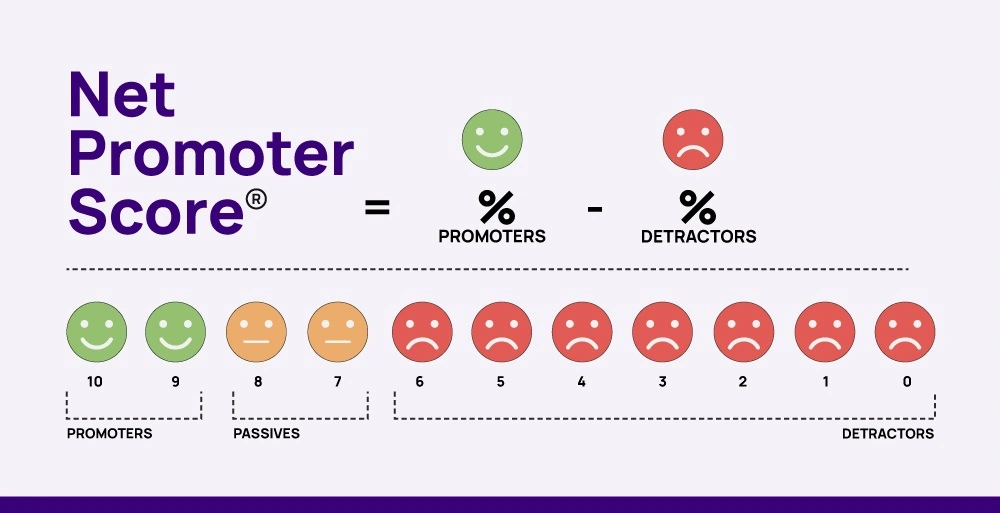
To get this score, companies ask their consumers a simple question; “On a scale of 0 to 10, how likely are you to recommend this product or service to a friend or family member?” The customers’ answers will help the company determine how enthusiastically they support the brand.
To calculate the Net Promoter Score (NPS), use this formula:
NPS = Percentage of Promoters – Percentage of Detractors
2. Customer Satisfaction Score (CSAT)
Customer Satisfaction Score (CSAT) is a way for companies to measure their buyers’ happiness and satisfaction. It is usually a percentage derived from buyers’ responses to survey questions such as, “How satisfied were you with your experience?” They usually rate their experience on a scale of 1 to 5 stars.
By tracking these scores, companies can get a good idea of how their consumers feel after interacting with the company or their products. If the scores are high, that tells the company the buyers are satisfied.
To calculate Customer Satisfaction Score (CSAT), you can use this formula:
CSAT = (Number of Satisfied Customers ÷ Total Number of Survey Respondents) × 100
3. Customer Lifetime Value (CLV/LTV)
Companies have a way of measuring how much value a consumer is worth to them over the time they do business with the company, which is called a Customer Lifetime Value (CLV). The average CLV is usually around $1,000 per purchaser. This means that each purchaser is worth about $1,000 to the company.
By knowing this CLV number, companies can figure out the best ways to keep their customers happy and get them to return. They can tailor their products, services, and marketing strategies to maximize the value they get from their buyers. They can also manage their customers’ journeys through customer lifecycle management.
To calculate Customer Lifetime Value (CLV), you can use this formula:
CLV = (ARPA x Gross Margin) x (Retention Rate ÷ 1 + Discount Rate – Retention Rate)
Where,
ARPA = Average revenue generated per user.
Gross Margin = The percentage of total revenue profit by selling goods.
Retention Rate = The percentage of customers you retain during a given period.
Discount Rate = The interest rate discounts.
4. Customer Churn Rate
Companies keep track of how many of their consumers leave them, which is called the customer churn rate. For online retail, on average, about 20% of buyers end up leaving a company over time. By looking at the churn rate, companies can try to figure out why some of their customers are deciding to go elsewhere.

Once companies understand the reasons for customer churn, they can work on creating better strategies to try to keep more of their clients. This could mean improving their products, providing better service, or offering special offers to encourage buyers to stay with them.
To calculate the Customer Churn Rate:
Customer Churn Rate = (Lost Customers ÷ Total Customers at Start of Period) x 100
5. Customer Effort Score (CES)
Customer Effort Score (CES) ensures that doing business with the company is easy and straightforward. Generally, consumers are asked to rate how much effort it took them to interact with the company on a scale of 1 to 5. If it were really easy, they’d give it a 5. If it were a lot of work, they’d give a 1.
By tracking this Customer Effort Score, companies can see where they need to simplify and smooth things out for their clients. If the score is low, that tells the company it needs to streamline its processes and make it less of a hassle for buyers to get what they need. CES is one of the essential metrics that helps measure contact center analytics.
The formula for finding Customer Effort Score (CES) is
Customer Effort Score = (Positive Effort Responses %) – (Negative Effort Responses %)
6. Conversion Rate
When individuals take certain actions on a company website, like making a purchase or signing up, the percentage of these actions is called the conversion rate. Companies want to increase conversion rates so more people can buy their products or sign up for their services.
To improve their conversion rates, companies must improve the website pages’ design and content or messaging. Always trying to find the best ways to make people take that desired action.
To calculate the Conversation Rate, you can follow this formula:
Conversion Rate = (Number of Conversions/Total Number of Engaged Users) × 100
7. Click-Through Rate (CTR)
Whenever a company puts an ad or some kind of content online, they want to see how many people actually click on it and check it out. This process is called the Click-Through Rate (CTR). It helps companies understand how effective their advertising and content creation efforts are.

By tracking the click-through rate, companies can figure out ways to improve their ads and content and make them more engaging and compelling. They might try different designs, messages, or targeting strategies to get more people to click and increase the conversation rate.
You can use this formula to calculate Click Through Rate (CTR):
CTR = (Number of Clicks ÷ Number of ad shown) x 100
8. Bounce Rate
When people visit a company’s website, the company wants to know how many of them leave quickly without doing anything on the site, which is called the bounce rate. It is important for companies to maintain a high bounce rate because it indicates that something is wrong with the website that is causing people to leave it.
By understanding the bounce rate, companies can work on making their websites easier to use and with more engaging and helpful content for visitors. This helps keep people on the site longer and encourages them to actually take the actions the company wants, like making a purchase or signing up for something.
The Bounce Rate can be calculated by:
Bounce Rate = (Number of Single Page Sessions ÷ Total Sessions) x 100
9. Daily Active Users (DAU) / Monthly Active Users (MAU)
Companies that have websites want to know how often people return to their websites and use their products. They have a way to measure this called the DAU/MAU ratio. The ratio between these two numbers tells the company how often the same users return to the website.
By tracking this DAU/MAU ratio, companies can better understand what’s working well and what needs improvement. If the ratio is low, they can try changing the product or website to make it more appealing so customers want to return more often.
The formula to find the DAU/MAU Ratio is:
DAU/MAU Ratio = (DAU ÷ MAU) x 100
10. Social Media Engagement
Whenever a company posts something on social media, like a photo, video, or update, they want to see how many people interact with it. Clicking “Like,” sharing the post, or leaving a comment are all considered “Engagements.“
Companies track this engagement rate closely to determine what types of social media content their audience likes best. Maybe certain styles of posts get way more engagement than others. The company can then create more of that type of content to keep its audience interested and engaged.
To find Social Media Engagement, You can follow this formula:
Social Media Engagement Rate = (Total number of engagements ÷ Total number of posts) x 100
Wrapping Up
Building good customer relationships is the most important thing when starting a new online business. Getting people to notice and care about your business is key to your growth. To do that, you need to be able to measure how engaged your buyers are. The number of people visiting your website, how long they stay, and whether they tell their friends about your business are signs of customer engagement.
So, to measure and improve user engagement, use metrics like Net Promoter Score, Customer Acquisition cost, Churn Rate, Customer Satisfaction Score, and many more. You must also ask for purchaser feedback, respond to their questions, and show that you care about them. These little steps will improve user engagement and help your business grow.
FAQs
1. How to improve customer engagement metrics?
To improve customer engagement metrics, you can track metrics that reflect your goals (like NPS for loyalty), personalize interactions using client data, actively seek and address feedback, and open two-way communication channels. You can also make it easy for buyers to connect by offering various contact options.
2. What is the main difference between customer engagement and customer satisfaction?
There are some differences between customer engagement and customer satisfaction that you need to know, and they are described below:
| Feature | Customer Satisfaction | Customer Engagement |
| Focus | Meeting customer expectations | Creating an active connection |
| Measurement | Surveys, CSAT scores, post-purchase reviews | Website visits, social media interactions, loyalty program participation |
| Customer Perception | “Yes, this is what I wanted” | “I enjoy interacting with this brand” |
| Outcome | Positive experience, repeat purchase | Brand loyalty, advocacy, active participation |
3. What are the emerging trends of customer engagement metrics?
The emerging trends of customer engagement metrics are tracking engagement across the buyers’ journey, measuring emotional connection, analyzing omnichannel interactions, using AI to predict behavior, and prioritizing high-value customers based on Customer Lifetime Value (CLV).

